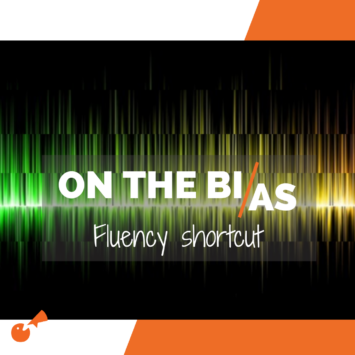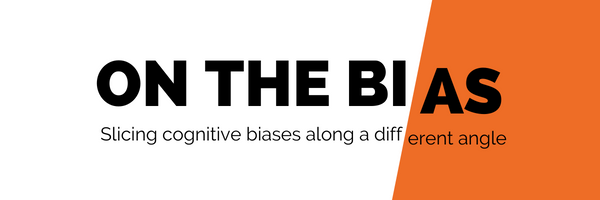
ON THE BIAS: Fluency Shortcut
Welcome back to the blog series, ON THE BIAS.
In this series, we look at the cognitive biases we have as humans and how they impact our behavior change efforts. Catch up with the previous posts here.

A story: It’s time to flip the script.
In early 2020, I was a keynote speaker for the U.S. Fish & Wildlife Service’s Social Science Summit. It was an exciting opportunity to meet with social science enthusiasts looking to embed human dimensions into the agency’s work nationally.
After presenting slides about shifting consumer expectations and why traditional communication methods aren’t working hard enough for us, I put up a bold slide that stated, “It’s time to flip the script” on our environmental messages.
I read it out loud and paused before diving into techniques for motivating audiences to take action.
The next day of the conference, I listened to some roundtable discussions and heard a few folks repeat, “We have to flip the script on this.”
Those who said the statement didn’t specifically reference my presentation from the day before.
They also didn’t look my way with a knowing glance and smile when they said it.
To my surprise and delight, the phrase was now theirs, not mine.
What’s happening here?
Without doing it intentionally, the phrase “it’s time to flip the script” hit the right notes to create a fluency shortcut for the audience.
Listeners found it easy to recall, enjoyable to repeat, and familiar to them. After all, I didn’t invent the sentence; I just applied it to a different context.
ON THE BIAS: Fluency describes the ease or difficulty with which we process information, which often comes from how information is presented and phrased.
Statements that are easier to understand (i.e., more fluent) are more memorable and believable, forming fluency shortcuts.
Fluency shortcuts come as a result of how we communicate with our audiences.
So, what makes a message persuasive, memorable, and shareable?
Simplicity. The more simply we write, the more powerful it will be.
Ease. Information that feels easier to understand and comprehend helps form mental shortcuts.
Ease applies to our choice of words and how the information is presented (i.e., clear graphics, legible fonts, proper use of contrasting colors, etc.)
Familiarity. It feels like something we’ve heard and experienced before; it’s not too abstract or obscure.
Pleasing language. Statements incorporating alliteration, rhythm, symmetry, and flow are easier to remember and repeat.
When our communication efforts feature elements of fluency (of which there are many forms, and we don’t have to use all of them), audiences are more likely to believe, trust, like, and feel confident in the message.
This also means audiences are more likely to take action.
Powerful stuff.
Bringing the bias home: Think of a statement or phrase you often repeat at home or work that meets some of the above fluency elements. One that I use a lot is “Righty tighty. Lefty loosey.” It has pleasing language, is easy to understand and remember, and is incredibly useful.
Consider whether the statement you recall is grounded in truth or just sounds good, like the earlier example of an apple a day keeping the doctor away.
How this bias can help or hurt our behavior change programs
HOW IT CAN HELP
Communicating in a way that resonates with our audiences is critical to the success of our work.
Finding opportunities to make the information we share more fluent increases trust, engagement, affinity, and confidence.
As mentioned earlier, statements that feel easier to understand and repeat feel more familiar. A big benefit of familiarity for behavior change efforts is that it lowers loss aversion and fear of change since it creates comfort with an idea. For example, Meatless Mondays can feel as familiar as Taco Tuesdays.
I covered a related cognitive bias in the 2022 series: the mere exposure effect.
Additionally, things that feel fluent and familiar also feel true.
“People tend to associate fluency with truth and disfluency with untruth (Schwarz, 2004), in large part because fluency implies frequency, which in turn implies social consensus (Schwarz, Sanna, Skurnik,& Yoon, 2007).” » Alter and Oppenheimer (2009)
A third benefit is confidence. When calls to action and instructions are easy to read and comprehend, it gives the audience confidence in their ability to perform a task.
Fluency that instills self-efficacy can include communication basics like using easy-to-read fonts and providing visual cues alongside written instructions.
Fluency shortcuts are well-suited, and should be used, for rallying cries, calls to action, slogans, headlines, and big ideas. But it doesn’t only apply to short, catchy statements; we can incorporate elements of fluency in nearly everything we communicate.
HOW IT HURTS
By this point, you may have thought of a few statements that use fluency shortcuts in ways that are less aligned with our values and goals. Political campaigns are notorious for this, as are misinformation campaigns.
I would even argue that causes working against ours do a better job of incorporating elements of fluency into rallying cries and headlines and repeat them far more frequently (increasing familiarity). When familiarity and fluency translate into trust and affinity, this becomes concerning.
Which is why I strongly believe it’s time for us to flip the script. ;-p
But fluency ain’t easy! Communicating what we do in simple, familiar, and pleasing ways takes a lot of hard work. We won’t get it right on the first try, and we may need to bring in experienced copywriters to help finesse our words.
Keep an ear out for phrases your audience repeats, as they may be fluency shortcuts you didn’t know you had. (I’ve used “Flip the script” more frequently since my keynote experience.)
A NOTE OF CAUTION
Consumers are increasingly skeptical of things that sound too good to be true, so if a fluency shortcut sounds made up or feels manipulative (like greenwashing), they will ignore it or, worse, rail against it.
As with any behavior change communication technique, we should refrain from using false claims, lies, imaginary guarantees, dishonest statements, and unattainable promises.
This published paper provides a comprehensive overview of the different forms of fluency and how they result in similar outcomes of producing truth judgments, liking judgments, and confidence judgments:
- Alter, A. L., & Oppenheimer, D. M. (2009). Uniting the Tribes of Fluency to Form a Metacognitive Nation. Personality and Social Psychology Review, 13(3), 219-235. https://doi.org/10.1177/1088868309341564 (A PDF of the complete paper is available here.)
Are you ready to flip the script on your sustainability messages?
Take the Messages that Motivate short course! In less than 2 hours (and for only $55), you will learn the fundamentals of crafting messages that motivate action and change. The lessons and downloadable workbook are yours for life.



